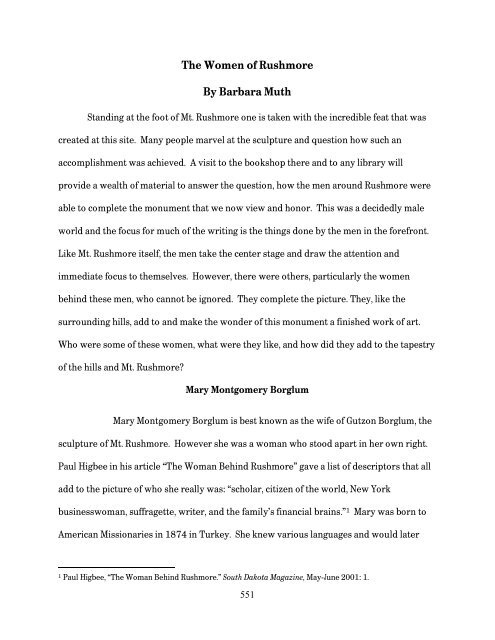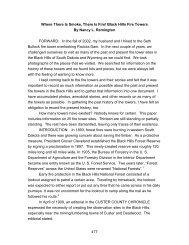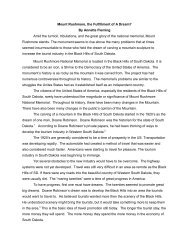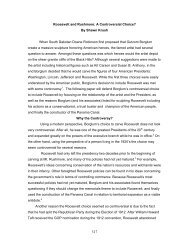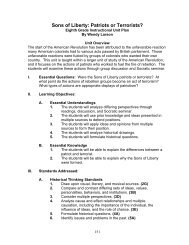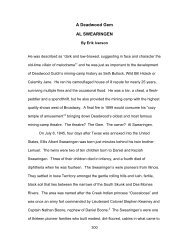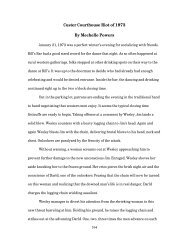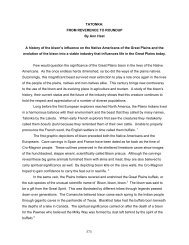The Women of Rushmore By Barbara Muth - Mountains of History 2.0
The Women of Rushmore By Barbara Muth - Mountains of History 2.0
The Women of Rushmore By Barbara Muth - Mountains of History 2.0
Create successful ePaper yourself
Turn your PDF publications into a flip-book with our unique Google optimized e-Paper software.
<strong>The</strong> <strong>Women</strong> <strong>of</strong> <strong>Rushmore</strong><br />
<strong>By</strong> <strong>Barbara</strong> <strong>Muth</strong><br />
Standing at the foot <strong>of</strong> Mt. <strong>Rushmore</strong> one is taken with the incredible feat that was<br />
created at this site. Many people marvel at the sculpture and question how such an<br />
accomplishment was achieved. A visit to the bookshop there and to any library will<br />
provide a wealth <strong>of</strong> material to answer the question, how the men around <strong>Rushmore</strong> were<br />
able to complete the monument that we now view and honor. This was a decidedly male<br />
world and the focus for much <strong>of</strong> the writing is the things done by the men in the forefront.<br />
Like Mt. <strong>Rushmore</strong> itself, the men take the center stage and draw the attention and<br />
immediate focus to themselves. However, there were others, particularly the women<br />
behind these men, who cannot be ignored. <strong>The</strong>y complete the picture. <strong>The</strong>y, like the<br />
surrounding hills, add to and make the wonder <strong>of</strong> this monument a finished work <strong>of</strong> art.<br />
Who were some <strong>of</strong> these women, what were they like, and how did they add to the tapestry<br />
<strong>of</strong> the hills and Mt. <strong>Rushmore</strong>?<br />
Mary Montgomery Borglum<br />
Mary Montgomery Borglum is best known as the wife <strong>of</strong> Gutzon Borglum, the<br />
sculpture <strong>of</strong> Mt. <strong>Rushmore</strong>. However she was a woman who stood apart in her own right.<br />
Paul Higbee in his article “<strong>The</strong> Woman Behind <strong>Rushmore</strong>” gave a list <strong>of</strong> descriptors that all<br />
add to the picture <strong>of</strong> who she really was: “scholar, citizen <strong>of</strong> the world, New York<br />
businesswoman, suffragette, writer, and the family’s financial brains.” 1 Mary was born to<br />
American Missionaries in 1874 in Turkey. She knew various languages and would later<br />
1 Paul Higbee, “<strong>The</strong> Woman Behind <strong>Rushmore</strong>.” South Dakota Magazine, May-June 2001: 1.<br />
551
attend graduate school at Berlin University. She was one <strong>of</strong> the first women to get her Ph.D.<br />
in Oriental language, from that institution, which was an additional challenge since all the<br />
courses were taught in German. 2<br />
It was while she was sailing back to America in 1901 that she met Gutzon Borglum.<br />
<strong>The</strong>re was an attraction that developed between them during their voyage. As her<br />
granddaughter later said, “He was so different from the people she grew up with.” 3 He was<br />
drawn to her intelligence and ability to engage him in debate, “…no matter what Gutzon<br />
chose to argue about, she could hold her own.” 4 Mary at first worked as secretary to<br />
Borglum, but then in May <strong>of</strong> 1909 they were married. Mary wrote <strong>of</strong> that day, “Here begins<br />
the new life…” 5<br />
Mary probably had no vision <strong>of</strong> what that ‘new life’ would be like. A hint <strong>of</strong> that was<br />
their honeymoon <strong>of</strong> two weeks spent camping in Canada, followed by additional camping<br />
and fishing trips in the United States. <strong>The</strong>y moved to various places throughout their<br />
marriage, with widely different degrees <strong>of</strong> comfort. <strong>The</strong>y moved from a modest New York<br />
studio, to their Stamford house on Borgland, near Stamford, Connecticut, and then for a<br />
time in North Carolina and Texas waiting for the controversy over Stone Mountain to cool<br />
down. In an interview in 1998 Mary Ellis, Borglum’s daughter recalls the Texas move as<br />
unsettling, but went on to remark that they really didn’t know the true nature <strong>of</strong> all that<br />
was going on because they “…were a close family…they still had a mother and father, we<br />
2 Higbee, “Woman,” 1.<br />
3 Higbee, “Woman,” 1.<br />
4 William Price, Gutzon Borglum: Artist and Patriot. (Chicago, New York, San Francisco: Rand McNally &<br />
Company, 1961), 51.<br />
5 Price, Gutzon Borglum, 84.<br />
552
had the four <strong>of</strong> us.” 6 Once Gutzon got to South Dakota and had Mary and the children join<br />
him they found themselves living in “…a primitive cabin…which was little more than a<br />
shack, (with) the most meager equipment. Water had to be carried from a block away.” 7<br />
<strong>The</strong>y later did establish residence on a ranch near Hermosa. 8 9<br />
Throughout their years together Mary supported Gutzon in numerous ways. She<br />
continues to act as his secretary and on occasions took care <strong>of</strong> details surrounding various<br />
projects that were an annoyance to him. It was she, for example, that took care <strong>of</strong> making<br />
the shipping arrangements for the return <strong>of</strong> some bronze casts from Italy, a difficult task at<br />
the very least. She was also the one who managed the family’s finances, another daunting<br />
task in the face <strong>of</strong> Gutzon’s attitude towards spending, according to Mary Ellis “…that was<br />
where Mother would come in, because Mother would make all things possible. I don’t<br />
know how she did it, but she did.” 10 In a later interview Mary Ellis also remarked that one<br />
<strong>of</strong> the things her mother did was “…learn to drive a car, Dad was a horrible driver.” 11<br />
Perhaps Mary’s greatest support came in devotion to Gutzon and her open defense <strong>of</strong> him<br />
both during his life time and after his death. She later went on to co-author a book, Give the<br />
Man Room, with that purpose. 12<br />
6 Ryan Phillips, Mt. <strong>Rushmore</strong>-<strong>The</strong> <strong>Women</strong> Behind the Carving. April 15, 2007, Teacher Tube.<br />
www.teachertube.com (accessed April 4, 2009).<br />
7 Price, Gutzon Borglum, 153.<br />
8 Higbee, “Woman,” 3.<br />
9 Rex Alan Smith, <strong>The</strong> Carving <strong>of</strong> Mount <strong>Rushmore</strong>. (New York: Abbeyville Press Publishers, 1985).<br />
10 Higbee, “Woman,” 2.<br />
11 Phillips, Mt. <strong>Rushmore</strong>: <strong>The</strong> <strong>Women</strong> Behind the Carving.<br />
12 Higbee, “Woman,” 4.<br />
553
Mary Ellis Borglum<br />
Mary Ellis was born to Gutzon and Mary in 1916, just months before the formal<br />
dedication <strong>of</strong> Stone Mountain project in Georgia. She grew up in the years <strong>of</strong> Gutzom’s<br />
grand plans and projects. <strong>The</strong>y were a close family and did not like being apart. Whenever<br />
circumstances made it that they were not together, written communication continued to<br />
keep them close. Throughout all the family’s moves Mary Ellis and her brother, Lincoln, did<br />
not miss out on their education. Whether they were at boarding school, being privately<br />
tutored at home, or learning from their father as he took them with him in his travels, they<br />
learned a great deal. 13 14 15<br />
Mary and her brother began supporting their father’s projects at an early age. In<br />
1928, Borglum found he was unable to go to Poland to make arrangements for the carving<br />
<strong>of</strong> a requested statue and so sent Mary and Lincoln instead. 16<br />
After her father’s death and what appeared to be the ending <strong>of</strong> any further work at<br />
Mt. <strong>Rushmore</strong>, Mary, along with the Mt. <strong>Rushmore</strong> Historical Society continued the effort <strong>of</strong><br />
getting the Hall <strong>of</strong> Records, located behind the faces, completed. Although not in the full<br />
form envisioned by Borglum himself, they were successful in getting a cache <strong>of</strong> documents<br />
sealed at that site in 1998. Mary would say that “…it was the end…<strong>of</strong> her father’s dream.” It<br />
was an important moment for her, as she had wanted to see that part <strong>of</strong> the project also<br />
completed. 17<br />
13 Price, Gutzon Borglum.<br />
14 Higbee, “Woman,” 3.<br />
15 Phillips, <strong>The</strong> Woman Behind the Carving.<br />
16 Smith, Carving, 175.<br />
17 Phillips, <strong>The</strong> Woman Behind the Carving.<br />
554
Ethel Winnie Boland<br />
Ethel Boland was the wife <strong>of</strong> John Boland, a local implement dealer, who was one <strong>of</strong><br />
the main forces behind the <strong>Rushmore</strong> project. As a member <strong>of</strong> the Mount <strong>Rushmore</strong><br />
National Memorial Commission he was seen as a friend and supporter by Borglum and then<br />
later as an enemy. In this later frame <strong>of</strong> mind, Borglum was eventually responsible for<br />
pushing Boland <strong>of</strong>f <strong>of</strong> the Commission. Ethel is remembered by her grandson as a “small,<br />
petite and very pretty girl…who always had a smile, like (his) grandfather.” 18 According to<br />
her grandson, Ethel did not have any direct connection with the business; however she did<br />
accompany him to Washington and Pierre during his travels to gain support for the<br />
<strong>Rushmore</strong> project. 19<br />
Ethel was very social and one <strong>of</strong> her many friends was Mary Borglum. Ethel and<br />
Mary continued to be friends and communicate with one another no matter what was<br />
happening between their husbands. It was the largely due to these two former school<br />
teacher’s who “…regarded their husbands’ feuding as a ridiculous scrap between two<br />
grown-up little boys in a schoolyard,…” 20 , that the two men were able to reconcile their<br />
differences. 21<br />
Ethel did a lot for the Rapid City Community. She worked with the Native<br />
Americans through the Episcopal Church in North Rapid. Her grandson, John, recalls how<br />
18 John Boland, Interview by author, Knollwood Elementary, April 16, 2009.<br />
19 Boland interview.<br />
20 Smith, Carving, 377.<br />
21 Boland interview.<br />
555
at her funeral “…one <strong>of</strong> her old friends came and placed an eagle feather in the casket….she<br />
wouldn’t leave until the casket was close….” making sure that it was not taken. 22<br />
Lydia Norbeck<br />
In 1900, Peter Norbeck, then a successful well-driller and then later a political<br />
leader who was a key figure in the support <strong>of</strong> the Mt. <strong>Rushmore</strong> project, married the<br />
attractive Lydia Anderson. <strong>The</strong> early years <strong>of</strong> their marriage were not easy for Lydia as she<br />
was left alone much <strong>of</strong> the time on Peter’s homestead. <strong>The</strong>se absences were made even<br />
more difficult as he would be gone for as much as two weeks at a time without sending her<br />
even a letter. 23 This pattern <strong>of</strong> distance between him and his family continued, as he left the<br />
raising <strong>of</strong> their four children to Lydia. “She was content with this responsibility, since it left<br />
her husband free to devote his time and energy to business and other activities.” 24<br />
Lydia joined her husband more as he entered the political arena and found<br />
themselves in Pierre after his election to governor in 1916. She became more outspoken<br />
after that time and actually “strongly opposed” her husband’s support <strong>of</strong> Hiram Johnson in<br />
his campaign against Calvin Coolidge. Norbeck was quoted as saying, “My good wife<br />
lectures me nearly every day for not staying with the President, in who she believes so<br />
firmly…” 25<br />
22 Boland interview.<br />
23 Gilbert Courtland Fite, Peter Norbeck: Prairie Statesman (Columbia: University <strong>of</strong> Missouri, 1948), 22.<br />
24 Fite, Peter Norbeck, 26.<br />
25 Fite, Peter Norbeck, 114-115.<br />
556
After Norbeck’s election as senator from South Dakota, Lydia spent a great deal <strong>of</strong><br />
time entertaining friends in her home in Washington, D.C. She also was a devoted church<br />
worker there, as she had been in South Dakota. 26<br />
<strong>The</strong> Carvers’ Wives<br />
It is difficult to find actual accounts <strong>of</strong> what daily life was like for the wives <strong>of</strong> the<br />
crew who went daily to Mt. <strong>Rushmore</strong>, to risk their lives to bring about this incredible<br />
sculpture. Since the carvers’ day began early and then ended with them returning home<br />
dirty, tired and hungry, we can assume that the women spent much <strong>of</strong> their day taking care<br />
<strong>of</strong> those things that would provide for the needs <strong>of</strong> their husbands. Modern appliances<br />
were not available and thus laundry, cleaning, and cooking were time consuming activities.<br />
In his book, <strong>The</strong> Carving <strong>of</strong> Mt. <strong>Rushmore</strong>, Rex Alan Smith does paint a picture <strong>of</strong> a summer<br />
evening where “…on darkened porches the firefly glow <strong>of</strong> cigarettes punctuates murmured<br />
conversations as families visit among themselves or with friends.” 27<br />
<strong>The</strong>re are two contrasting accounts <strong>of</strong> how particular wives responded to the<br />
situation. <strong>The</strong> first was when Red and Dorothy Anderson were <strong>of</strong>fered an abandoned<br />
house that was in total disrepair. If they were to fix it up, they could rent it for $5 a month.<br />
This was their memory <strong>of</strong> that place: “Well, we rustled up scrap lumber and some old<br />
packing cases and stuff and fixed it up to be a right comfortable place. We spent several<br />
happy years in it, and we sure couldn’t complain about the rent!” 28<br />
26 Fite, Peter Norbeck, 153.<br />
27 Smith, Carving, 265.<br />
28 Smith, Carving, 258.<br />
557
On the other hand, Luigi Del Bianco, chief carver, brought his wife and three boys<br />
from New York one season. <strong>The</strong> house they had did not have indoor plumbing and Mrs.<br />
Bianco was unable to find the necessary ingredients for the family’s favorite Italian dishes.<br />
<strong>The</strong> family never returned for another season, even though Luigi worked nine seasons at<br />
Mount <strong>Rushmore</strong>. 29 However, there were women who stayed and helped raise their<br />
families despite the hardships <strong>of</strong> the time.<br />
Conclusion<br />
As we look at what happened at Mt. <strong>Rushmore</strong>, and history in general, it is most<br />
<strong>of</strong>ten the men who stood in the forefront. Even though they are the ones that were most<br />
prominent to each event, it is important to remember that without the people around them,<br />
most <strong>of</strong>ten their wives, they might not have accomplished the things they did. Taking a<br />
look at the people behind the men can broadened our understanding <strong>of</strong> them and their<br />
accomplishments.<br />
29 “<strong>Rushmore</strong> Carvers,” Keystone Area Historical Society,<br />
http://www.keystonechamber.com/kahs/carvers.html.<br />
558
Primary Sources<br />
Bibliography<br />
Boland, John. Interview by author, Knollwood Elementary, April 16, 2009.<br />
Phillips, Ryan. Two <strong>Women</strong> Behind the Carving. April 15, 2007. Teacher Tube.<br />
www.teachertube.com (accessed April 4, 2009).<br />
Secondary Sources<br />
Fite, Gilbert Courtland. Peter Norbeck: Prairie Statesman. Columbia: University <strong>of</strong> Missouri,<br />
1948.<br />
Higbee, Paul. “<strong>The</strong> Woman Behind <strong>Rushmore</strong>.” South Dakota Magazine, May-June 2001.<br />
Price, William. Gutzon Borglum: Artist and Patriot. Chicago, New York, San Francisco: Rand<br />
McNally & Company, 1961.<br />
“<strong>Rushmore</strong> Carvers.” Keystone Area Historical Society.<br />
http://www.keystonechamber.com/kah/carvers.html (accessed June 20, 2009).<br />
Smith, Rex Alan. <strong>The</strong> Carving <strong>of</strong> Mount <strong>Rushmore</strong>. New York: Abbeville Press Publishers,<br />
1985.<br />
Zeitner, June Culp, and Lincoln Borglum. Borglum’s Unfinished Dream Mount <strong>Rushmore</strong>.<br />
Aberdeen: North Plains Press, 1976.<br />
559


